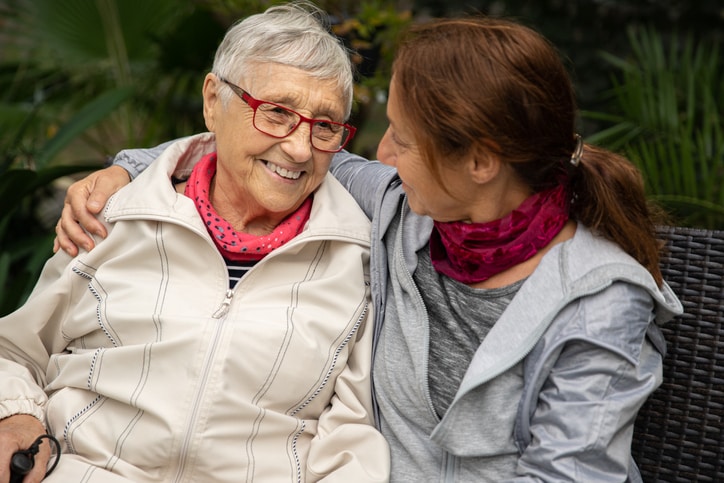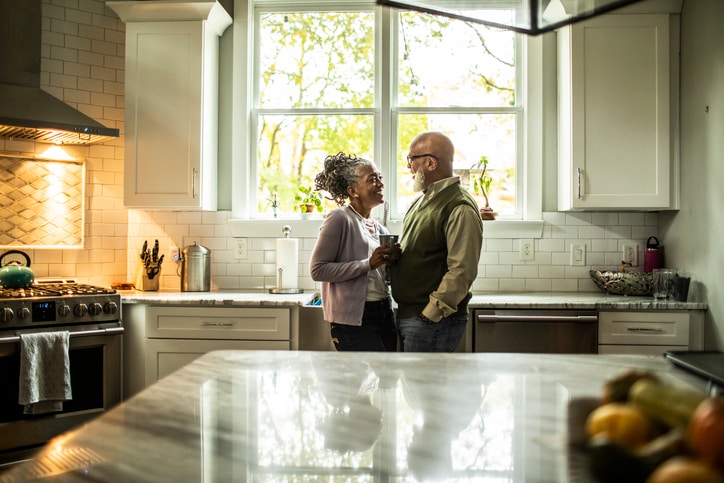Finding someone you can trust to take care of an aging loved one, or for yourself as you age, is never easy. Beyond the financial costs, it’s an emotional process that comes with real risks. LGBTQ+ seniors are especially vulnerable in this process. After a lifetime of discrimination with housing, employment, marriage and healthcare providers, finding care is daunting and fear-inducing, says Nic Watson, Managing Director of Social Enterprise at SAGE — a national services and advocacy organization for LGBTQ+ seniors.
There’s a limited number of LGBTQ-friendly senior care facilities, and most are expensive — especially for a marginalized community facing financial inequities. “LGBTQ people are three times as likely to live in poverty and experience higher rates of homelessness,” Jennifer Henius, a social worker and co-founder of the LGBTQ Caregiver Center. (Henius formed the center with Zander Keig, a fellow social worker, to advocate, educate and provide resources to unpaid, non-professional LGBTQ caregivers and/or those who care for LGBTQ elders.)
“The fear of discrimination, stigma and mistreatment oftentimes also prevents these older adults from seeking out the health and social care services they need further increasing their risk for poor outcomes,” explains Henius. “It’s also not uncommon for them to re-closet themselves to access senior housing and long-term care.”
“Many LGBTQ+ older people rely on different types of family structures, like chosen families or the larger LGBTQ+ community.”
— NIC WATSON, MANAGING DIRECTOR OF SOCIAL ENTERPRISE AT SAGE
Watson says anxiety this was captured in a 2018 AARP survey, with 60% of LGBTQ+ older adults reporting fear they’ll be mistreated, refused care or in danger of neglect or abuse in senior living communities due to being LGBTQ+. He adds that many states still lack basic legal protections for LGBTQ+ people in regard to housing and public accommodations.
Altogether, this leaves some LGBTQ+ seniors more comfortable aging in place. But compared to the general population, LGBTQ+ older people are twice as likely to live alone, and four times less likely to have kids, Watson notes. “This leads to many LGBTQ+ older people relying on different types of family structures, like chosen families or the larger LGBTQ+ community,” he adds.
Henius says this peer model leads to many older LGBTQ+ adults caring for each other, which can only go so far. Seniors with mobility or medical issues may need to hire in-home care if they want to age in place. Remaining in a familiar home environment may feel less risky than moving to a facility, but it introduces other concerns by bringing a stranger into a private home of a person vulnerable to discrimination (on top of other common concerns like elder abuse).
If you’re an aging LGBTQ+ person or you love someone who is, here’s how to go about finding an affirming in-home caregiver to support aging in place.
Where to find competent in-home care for LGBTQ+ older adults
Before you start looking for help, make sure you know what type of in-home care is needed, since there’s a big difference in training, abilities and cost, says Henius.
She explains that skilled home care services, typically doctor-ordered and provided by a medical professional, are separate from non-medical care to help with daily life and activities. “The latter is often where the difficulty lies, because it’s not covered by health insurance and can be costly,” she says.
Here are some places to start on your search for the perfect in-home caregiver:
Look for SAGECare credentials
SAGECare is SAGE’s cultural competency credential program that trains long-term care communities and home health providers. “Organizations that have trained with us can achieve a SAGECare credential, showing that they have made a commitment to providing services that are dedicated to including LGBTQ+ older people,” Watson says. Search their database for providers in your area: SAGEUSA.care.
Get a referral from an LGBTQ center
A growing number of areas have a nonprofit LGBTQ+ center that functions as a resource hub. While programming and resources vary, Watson says these community centers can be a great resource for referrals.
Look for one near you in CenterLink’s online directory of LGBTQ centers. Watson says your local PFLAG chapter may also be a potential referral source. Some cities regions may have additional resources, either in government aging/senior departments or through other nonprofits and partnerships.
Check chambers of commerce
Henius recommends finding the chamber of commerce for your area and looking for businesses that may be connected in the LGBTQ+ community. Some areas also LGBTQ-specific chambers of commerce.
Scour websites for clues
If you can’t find any leads through trusted sources, or you do but you want to vet them first, take a close look at the websites of potential providers in the area. You can narrow down options by checking policies and imagery, Watson says. For example, he suggests asking questions like, “Does their non-discrimination policy include language about sexual orientation and gender identity? Do they illustrate diversity, equity and inclusion on their website or brochures?”
Ask a friend
It may sound obvious, but start asking people you trust if they know of any professional caregivers. “Recommendations from friends in similar circumstances are a great indication of a competent provider,” says Watson says.
“Organizations that have trained with us can achieve a SAGECare credential, showing that they have made a commitment to providing services that are dedicated to including LGBTQ+ older people.”
— NIC WATSON
How to train a prospective caregiver
Say you find a professional caregiver or in-home care agency that’s eager and willing to work with you or your loved one, but they don’t have much experience with the LGBTQ+ community. Even those with the best of intentions may lack cultural competency needed to use the correct language, combat stigma and understand the unique needs and experiences of that person.
One way to make this work is to offer (or require) that they obtain professional training if they’re to work for you. Here are two options:
- The LGBTQ Caregiver Center: While their main aim is to provide advocacy, education and resources to non-professional caregivers (like friends and biological or chosen family), they also train professionals. “[We offer] training on LGBTQ culture competency and LGBTQ caregiving to organizations that are seeking to become more inclusive and better informed,” Henius says. The organization does offer digital resources to anyone.
- SAGECare training: If you’re working with an agency that hasn’t yet had training, ask them to sign up for this training to learn LGBTQ+ cultural competency. It will end with them becoming credentialed, which will help others seeking care. If you’re working with an individual caregiver and don’t have the ability to send them to a large training, SAGE has a free 30-minute video on understanding and supporting LGBTQ+ older adults. Their online National Resource Center on LGBTQ+ Aging also offers a wealth of information.
If a self-employed caregiver doesn’t meet the criteria for formal trainings geared toward agencies, ask your local LGBTQ center or nearest LGBTQ-focused nonprofit if they offer any broader diversity/equity/inclusion trainings that could help.
Questions to ask potential candidates
As you start screening candidates to care for yourself or your loved one, it’s crucial to hold a thorough interview. There are standard interview questions that are beneficial for any senior caregiver, but adding these expert-recommended questions can help ensure the hire is willing and able to provide quality care to an LGBTQ+ senior.
- Do you serve LGBTQ+ individuals? “Look for a concrete answer,” Watson suggests. If they won’t say no, but can’t say yes, that could be telling.
- Do you have current or past LGBTQ+ clients you can speak about? “Don’t settle for a general statement of being welcoming and inclusive,” Watson says. You could also ask if they have any openly out clients who may be willing to share their experience with you, or someone who could serve as a relevant reference, points out Henius.
- Have you had any training to demonstrate competent and inclusive care to the LGBTQ community? You may need to contact the owner or manager of the agency to ask if this has been provided to employees, adds Henius.
- Can we review your non-discrimination policies? Look for explicit mentions of sexual orientation and gender identity, Watson explains, which helps show if it’s important to them.
- How are these policies enforced? This question may be more appropriate for a larger agency, Watson notes, but it can be an indicator of genuine support.
- What would the process be if I felt I was mistreated or discriminated against? Henius suggests asking this question, which may be better suited to an individual caregiver than the prior question.
A caveat on aging in place for LGBTQ+ seniors
Aging in place can be the right choice for an LGBTQ+ senior who has concerns about — or can’t afford — living at a senior care facility. Finding a trusted, competent caregiver or agency can make it possible for an older LGBTQ+ adult to safely remain independent and at home.
However, while all older adults are at risk of social isolation, LGBTQ+ older adults are even more vulnerable, especially if they’re not living in a facility surrounded by others. It’s crucial that if you or your loved one choose to get care and age in place at home, you proactively find ways to stay connected and engaged in the community. There are options for every level of ability and interest, and it’ll help stave off loneliness and isolation, which can in turn improve health and well-being.





